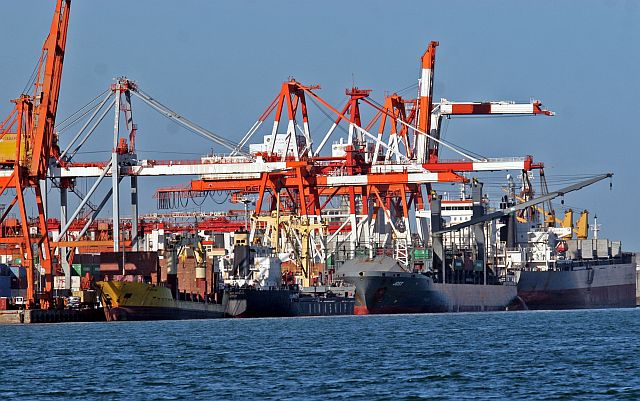
Cargoes carried by international vessels are unloaded at the Cebu International Port in this Feb. 20, 2016 photo (CDN FILE PHOTO).
The booming economy and thriving import sector in Cebu province have resulted to a 20 percent increase of the volume of cargo passing through ports in Cebu in the first nine months of the year.
According to a Cebu Port Authority (CPA) report obtained by Cebu Daily News, total cargo throughput hit 28.9 million metric tons (MMT) in the January to September period this year.
This is a 4.97 MMT increase from 23.93 MMT cargo throughput in a 9-month period last year.
“This goes to show that our economy is doing well. We also have good trade and commerce here in Cebu,” Oscar Lopez, chief of the CPA port management department, told CDN in a phone interview.
Foreign, domestic cargo
Foreign cargo volumes rose by 42 percent, from 4.55 MMT in 2015 to 6.47 MMT this year while domestic volumes grew from 19.38 MMT to 22.43 MMT, logging a growth rate of 15.47 percent.
Lopez said 80 percent of all cargoes pass through ports, while the rest are shipped via air freight.
A cargo throughput is the average quantity of cargo that can pass through a port on a daily basis from arrival at the port to loading onto a ship or from the discharge from a ship to the exit from the port complex. A throughput includes brick bulk, bulk, and roll on-roll off cargoes.
Container traffic
Meanwhile, container traffic grew by 7.7 percent in volume with 657,043 twenty-foot equivalent units (TEU) for the first nine months of 2016 compared to 610,003 TEUs processed one year earlier.
While domestic boxes accounted for a bigger volume in container traffic, foreign boxes rose higher at 10.94 percent from 264,630 TEUs in 2015 to 293,569 this year.
Domestic containerized cargo grew from 345,373 TEUs during the period in review to 363,474 TEUs in 2016, registering only a 5.24-percent increase.
“This can also be attributed to the increase in imports. We have very strong importation here in Cebu,” said Lopez.
Data from the Bureau of Customs in Cebu (BOC) showed that the office collected P13.714 billion in import duties from January to September this year, surpassing the nine-month revenue target of P12.95 billion or a 5.9 percent increase.
BOC earlier cited as factors that helped them achieve their collection surplus the revenues they collected from both power and fuel sector importations.
Jobs, infrastructure
Lopez said the increase in cargo volume helps create more jobs within the port community as well as give value to customers and port users.
However, he said there is also a need to improve existing port infrastructure to meet the increasing volume of cargo traffic.
He said that improving vessel turnaround time or service time is also necessary, along with increasing the volume of imported general cargoes such as rice and steel products.
“There also has to be a need for more efficient and effective cargo handling,” said Lopez.
Aside from cargo volume, the number of shipcalls to and passengers passing through Cebu ports also increased in the first nine months of the year.
The CPA operates nine ports in the province of Cebu, including its baseport in Cebu City which consists of the Cebu International Port and three smaller ports, as well as ports in the cities of Danao, Mandaue, and Toledo, and the towns of Argao and Santa Fe.